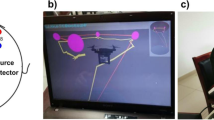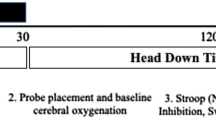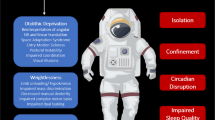Abstract
Background
Pilots often face and need to overcome a diverse range of unfavorable conditions, of which hypoxic exposure is the most common. Studies have reported that hypoxia can induce a decrease in cerebral blood flow (CBF) in the brains of both humans and animals. Hypoxia and the associated cerebral hemodynamic changes can contribute to cognitive performance deficits that may endanger flight safety and increase the risk of accidents.
Aim
In this study, we aimed to identify region-specific alterations in CBF in male pilots after exposure to hypoxia.
Material and methods
We used 3D pseudo-continuous arterial spin labeling sequences in 35 healthy male pilots (mean age: 30.6 ± 4.82 years) under simulated hypoxic conditions with a 3.0-T magnetic resonance imaging scanner. The generated CBF maps were measured and averaged in several regions of interest.
Results
Hypoxia decreased CBF in various brain regions, including the right temporal and bilateral occipital lobes, the anterior and posterior lobes of the cerebellum, the culmen and declive, and the inferior semilunar lobule of the cerebellum.
Conclusion
These changes may impact the functional activity of the brains of pilots experiencing hypoxia in flight, but the related mechanisms require further investigation.



Similar content being viewed by others
Data availability
Not applicable.
References
Bouak F, Vartanian O, Hofer K, Cheung B (2018) Acute mild hypoxic hypoxia effects on cognitive and simulated aircraft pilot performance. Aerosp Med Hum Perform 89:526–535. https://doi.org/10.3357/AMHP.5022.2018
Ebmeier KP, Cavanagh JT, Moffoot AP, Glabus MF, O’Carroll RE, Goodwin GM (1997) Cerebral perfusion correlates of depressed mood. Br J Psychiatry 170:77–81. https://doi.org/10.1192/bjp.170.1.77
Coutsoumpos A, Patel S, Teruya TH, Chiriano J, Bianchi C, Abou-Zamzam AM Jr (2014) Carotid duplex ultrasound changes associated with left ventricular assist devices. Ann Vasc Surg 28:1030.e7–1030.e11. https://doi.org/10.1016/j.avsg.2013.11.013
Busch KJ, Kiat H, Stephen M, Simons M, Avolio A, Morgan MK (2016) Cerebral hemodynamics and the role of transcranial Doppler applications in the assessment and management of cerebral arteriovenous malformations. J Clin Neurosci 30:24–30. https://doi.org/10.1016/j.jocn.2016.01.029
Mamalyga ML, Mamalyga LM (2017) Effect of progressive heart failure on cerebral hemodynamics and monoamine metabolism in CNS. Bull Exp Biol Med 163:307–312. https://doi.org/10.1007/s10517-017-3791-1
Jezzard P, Chappell MA, Okell TW (2018) Arterial spin labeling for the measurement of cerebral perfusion and angiography. J Cereb Blood Flow Metab 38:603–626. https://doi.org/10.1177/0271678X17743240
Telischak NA, Detre JA, Zaharchuk G (2015) Arterial spin labeling MRI: clinical applications in the brain. J Magn Reson Imaging 41:1165–1180. https://doi.org/10.1002/jmri.24751
Giani L, Lovati C, Corno S, Laganà MM, Baglio F, Mariani C (2019) Cerebral blood flow in migraine without aura: ASL-MRI case control study. Neurol Sci 40:183–184. https://doi.org/10.1007/s10072-019-03806-6
Yadav SK, Kumar R, Macey PM, Richardson HL, Wang DJ, Woo MA, Harper RM (2013) Regional cerebral blood flow alterations in obstructive sleep apnea. Neurosci Lett 555:159–164. https://doi.org/10.1016/j.neulet.2013.09.033
Liu W, Liu J, Lou X, Zheng D, Wu B, Wang DJ, Ma L (2017) A longitudinal study of cerebral blood flow under hypoxia at high altitude using 3D pseudo-continuous arterial spin labeling. Sci Rep 7:43246. https://doi.org/10.1038/srep43246
Villien M, Bouzat P, Rupp T, Robach P, Lamalle L, Troprès I, Estève F, Krainik A, Lévy P, Warnking JM, Verges S (2013) Changes in cerebral blood flow and vasoreactivity to CO2 measured by arterial spin labeling after 6 days at 4350 m. Neuroimage 15:272–279. https://doi.org/10.1016/j.neuroimage.2013.01.066
Harris AD, Murphy K, Diaz CM, Saxena N, Hall JE, Liu TT, Wise RG (2013) Cerebral blood flow response to acute hypoxic hypoxia. NMR Biomed 26:1844–1852. https://doi.org/10.1002/nbm.3026
Lawley JS, Macdonald JH, Oliver SJ, Mullins PG (2017) Unexpected reductions in regional cerebral perfusion during prolonged hypoxia. J Physiol 595:935–947. https://doi.org/10.1113/JP272557
Kasai N, Kojima C, Goto K (2018) Metabolic and performance responses to sprint exercise under hypoxia among female athletes. Sports Med Int Open 2:E71–E78. https://doi.org/10.1055/a-0628-6100
Raichle ME, MacLeod AM, Snyder AZ, Powers WJ, Gusnard DA, Shulman GL (2001) A default mode of brain function. Proc Natl Acad Sci U S A 98:676–682. https://doi.org/10.1073/pnas.98.2.676
Jenkinson M, Beckmann CF, Behrens TE, Woolrich MW, Smith SM (2012) FSL. Neuroimage 62:782–790. https://doi.org/10.1016/j.neuroimage.2011.09.015
Friston KJ, Holmes AP, Worsley KJ, Firth J-P CD, Frackowiak RSJ (1995) Statistical parametric maps in functional imaging: a general linear approach. Hum Brain Mapp 2:189–210. https://doi.org/10.1002/hbm.460020402
Nel J, Franconi F, Joudiou N, Saulnier P, Gallez B, Lemaire L (2019) Lipid nanocapsules as in vivo oxygen sensors using magnetic resonance imaging. Mater Sci Eng C Mater Biol Appl 101:396–403. https://doi.org/10.1016/j.msec.2019.03.104
Sumiyoshi A, Suzuki H, Shimokawa H, Kawashima R (2012) Neurovascular uncoupling under mild hypoxic hypoxia: an EEG–fMRI study in rats. J Cereb Blood Flow Metab 32:1853–1858. https://doi.org/10.1038/jcbfm.2012.111
Alisauskaite N, Wang-Leandro A, Dennler M, Kantyka M, Ringer SK, Steffen F, Beckmann K (2019) Conventional and functional magnetic resonance imaging features of late subacute cortical laminar necrosis in a dog. J Vet Intern Med 33:1759–1765. https://doi.org/10.1111/jvim.15526
Cahill LS, Zhou YQ, Seed M, Macgowan CK, Sled JG (2014) Brain sparing in fetal mice: BOLD MRI and Doppler ultrasound show blood redistribution during hypoxia. J Cereb Blood Flow Metab 34:1082–1088. https://doi.org/10.1038/jcbfm.2014.62
Temme LA, Still DL, Acromite MT (2010) Hypoxia and flight performance of military instructor pilots in a flight simulator. Aviat Space Environ Med 81:654–659. https://doi.org/10.3357/asem.2690.2010
Dormanesh B, Vosouqhi K, Akhoundi FH, Mehrpour M, Fereshtehnejad SM, Esmaeili S, Sabet AS (2016) Carotid duplex ultrasound and transcranial Doppler findings in commercial divers and pilots. Neurol Sci 37:1911–1916. https://doi.org/10.1007/s10072-016-2674-y
Poulin MJ, Liang PJ, Robbins P (1985) Dynamics of the cerebral blood flow response to step changes in end-tidal PCO2 and PO2 in humans. J Appl Physiol 81:1084–1095. https://doi.org/10.1152/jappl.1996.81.3.1084
Lee SM, Kwon S, Lee YJ (2019) Diagnostic usefulness of arterial spin labeling in MR negative children with new onset seizures. Seizure 65:151–158. https://doi.org/10.1016/j.seizure.2019.01.024
Keil VC, Hartkamp NS, Connolly DJA, Morana G, Dremmen MHG, Mutsaerts HJMM, Lequin MH (2019) Added value of arterial spin labeling magnetic resonance imaging in pediatric neuroradiology: pitfalls and applications. Pediatr Radiol 49:245–253. https://doi.org/10.1007/s00247-018-4269-7
Ho ML (2018) Arterial spin labeling: clinical applications. J Neuroradiol 45:276–289. https://doi.org/10.1016/j.neurad.2018.06.003
Austin BP, Nair VA, Meier TB, Xu G, Rowley HA, Carlsson CM, Johnson SC, Prabhakaran V (2011) Effects of hypoperfusion in Alzheimer’s disease. J Alzheimers Dis 26:123–133. https://doi.org/10.3233/JAD-2011-0010
Duong TQ (2007) Cerebral blood flow and BOLD fMRI responses to hypoxia in awake and anesthetized rats. Brain Res 1135:186–194. https://doi.org/10.1016/j.brainres.2006.11.097
Ainslie PN, Poulin MJ (2014) Ventilatory, cerebrovascular, and cardiovascular interactions in acute hypoxia: regulation by carbon dioxide. J Appl Physiol 97:149–159. https://doi.org/10.1152/japplphysiol.01385.2003
Cohen PJ, Alexander SC, Smith TC, Reivich M, Wollman H (1967) Effects of hypoxia and normocarbia on cerebral blood flow and metabolism in conscious man. J Appl Physiol 23:183–189. https://doi.org/10.1152/jappl.1967.23.2.183
Poulin MJ, Fatemian M, Tansley JG, O'Connor DF, Robbins PA (2002) Changes in cerebral blood flow during and after 48 h of both isocapnic and poikilocapnic hypoxia in humans. Exp Physiol 87:633–642. https://doi.org/10.1113/eph8702437
Curtelin D, Morales-Alamo D, Torres-Peralta R, Rasmussen P, Martin-Rincon M, Perez-Valera M, Siebenmann C, Pérez-Suárez I, Cherouveim E, Sheel AW, Lundby C, Calbert JA (2018) Cerebral blood flow, frontal lobe oxygenation and intra-arterial blood pressure during sprint exercise in normoxia and severe acute hypoxia in humans. J Cereb Blood Flow Metab 38:136–150. https://doi.org/10.1177/0271678X17691986
Sicard KM, Duong TQ (2005) Effects of hypoxia, hyperoxia, and hypercapnia on baseline and stimulus-evoked BOLD, CBF, and CMRO2 in spontaneously breathing animals. Neuroimage 25:850–858. https://doi.org/10.1016/j.neuroimage.2004.12.010
Alosco ML, Gunstad J, Jerskey BA, Xu X, Clark US, Hassenstab J, Cote DM, Walsh EG, Labbe DR, Hoge R, Cohen RA, Sweet LH (2013) The adverse effects of reduced cerebral perfusion on cognition and brain structure in older adults with cardiovascular disease. Brain Behav 3:626–636. https://doi.org/10.1002/brb3.171
Caldwell JA Jr, Lewis JA (1995) The feasibility of collecting in-flight EEG data from helicopter pilots. Aviat Space Environ Med 66:883–889
Bangen KJ, Werhane ML, Weigand AJ, Edmonds EC, Wood LD, Thomas KR, Nation DA, Evangelista ND, Clark AL, Liu TT, Bondi MW (2018) Reduced regional cerebral blood flow relates to poorer cognition in older adults with type 2 diabetes. Front Aging Neurosci 10:270. https://doi.org/10.3389/fnagi.2018.00270
Gainotti G (2014) Why are the right and left hemisphere conceptual representations different? Behav Neurol 2014:603134–603110. https://doi.org/10.1155/2014/603134
Shulman GL, Pope DLW, Astafiev SV, McAvoy MP, Snyder AZ, Corbetta M (2010) Right hemisphere dominance during spatial selective attention and target detection occurs outside the dorsal frontoparietal network. J Neurosci 30:3640–3651. https://doi.org/10.1523/JNEUROSCI.4085-09.2010
Causse M, Chua ZK, Rémy F (2019) Influences of age, mental workload, and flight experience on cognitive performance and prefrontal activity in private pilots: a fNIRS study. Sci Rep 9:7688. https://doi.org/10.1038/s41598-019-44082-w
Acknowledgments
The authors would like to thank GE Healthcare China in Beijing for support and Yu Tian, Mingyang Ding, and Ling Fang for the assistance in the data collection. We would like to thank Editage (www.editage.cn) for the English language editing.
Author information
Authors and Affiliations
Contributions
Jie Liu: data curation, formal analysis, investigation, methodology, and writing—original draft; Shujian Li: formal analysis and writing—review and editing; Long Qian: data curation, formal analysis, software, and validation; Xianrong Xu: conceptualization and resources; Yong Zhang: writing—review and editing; Jingliang: project administration and writing—review and editing; Wanshi Zhang: conceptualization, investigation, methodology, and writing—review and editing.
Corresponding author
Ethics declarations
Conflict of interest
The authors declare that they have no conflict of interest.
Ethics approval
All procedures were conducted in accordance with the tenets of the Declaration of Helsinki and were approved by the Institutional Review Board of the First Affiliated Hospital of Zhengzhou University.
Consent to participate
Informed consent was obtained from all individual participants included in the study.
Consent for publication
Not applicable.
Code availability
Not applicable.
Additional information
Publisher’s note
Springer Nature remains neutral with regard to jurisdictional claims in published maps and institutional affiliations.
Rights and permissions
About this article
Cite this article
Liu, J., Li, S., Qian, L. et al. Effects of acute mild hypoxia on cerebral blood flow in pilots. Neurol Sci 42, 673–680 (2021). https://doi.org/10.1007/s10072-020-04567-3
Received:
Accepted:
Published:
Issue Date:
DOI: https://doi.org/10.1007/s10072-020-04567-3




